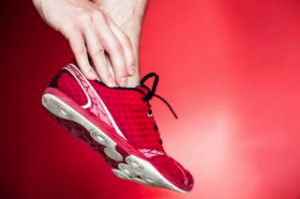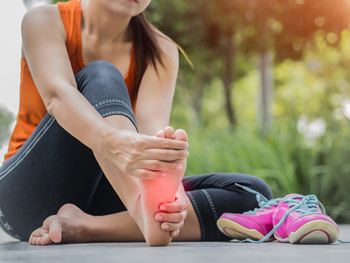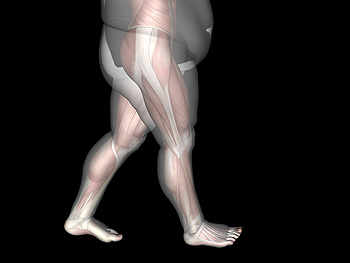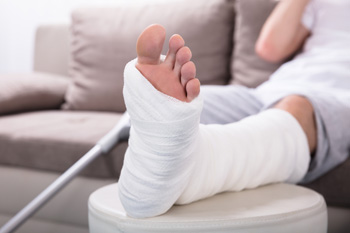Items filtered by date: August 2020
Running vs. Walking Shoes
 Whether you are a runner or a walker, the shoes that you exercise in should fit your needs. Stores tend to carry more running shoes than walking shoes, and while a runner shouldn't run in walking shoes, a walker may certainly walk in running shoes. That may sound slightly confusing, but the bottom line is that both runners and walkers can benefit from wearing running shoes while exercising as long as they buy shoes that fit their specific activity. Runners should buy shoes that have more cushioning in the heel and forefoot, while walkers generally don’t need extra cushioning in the forefoot and should opt for something more lightweight. Runners need shoes with a higher difference in height from the heel through the toe called the heel drop, while walkers should choose shoes with a heel drop of less than 8 millimeters. For more information on finding the best footwear for your needs, consult with a podiatrist.
Whether you are a runner or a walker, the shoes that you exercise in should fit your needs. Stores tend to carry more running shoes than walking shoes, and while a runner shouldn't run in walking shoes, a walker may certainly walk in running shoes. That may sound slightly confusing, but the bottom line is that both runners and walkers can benefit from wearing running shoes while exercising as long as they buy shoes that fit their specific activity. Runners should buy shoes that have more cushioning in the heel and forefoot, while walkers generally don’t need extra cushioning in the forefoot and should opt for something more lightweight. Runners need shoes with a higher difference in height from the heel through the toe called the heel drop, while walkers should choose shoes with a heel drop of less than 8 millimeters. For more information on finding the best footwear for your needs, consult with a podiatrist.
For more information about walking shoes versus running shoes, consult with one of our podiatrists from Pennsylvania. Our doctors can measure your feet to determine what your needs are and help you find an appropriate pair of footwear.
Foot Health: The Differences between Walking & Running Shoes
There are great ways to stay in shape: running and walking are two great exercises to a healthy lifestyle. It is important to know that running shoes and walking shoes are not interchangeable. There is a key difference on how the feet hit the ground when someone is running or walking. This is why one should be aware that a shoe is designed differently for each activity.
You may be asking yourself what the real differences are between walking and running shoes and the answers may shock you.
Differences
Walking doesn’t involve as much stress or impact on the feet as running does. However, this doesn’t mean that you should be any less prepared. When you’re walking, you land on your heels and have your foot roll forward. This rolling motion requires additional support to the feet.
Flexibility – Walking shoes are designed to have soft, flexible soles. This allows the walker to push off easily with each step.
If you have any questions, please feel free to contact one of our offices located in Plymouth Meeting and Ambler, PA . We offer the newest diagnostic and treatment technologies for all your foot care needs.
Do Your Child's Feet Hurt?
Reducing Bunion Pain
 Bunions are bony bumps that form on the joint of your big toe. They cause your big toe to move towards the other toes and force the joint at the base of the big toe to stick out. If your bunions are causing you pain, there are several things that you can try to relieve the pain at home. Exercising your feet by performing stretches can strengthen your muscles and improve foot flexibility, which may ease your bunion pain. For a light foot exercise, stand on a towel and scrunch it up with your toes, or lift your toes off the floor for ten seconds while keeping your heels firmly on the ground. If your bunion is inflamed, applying ice to the affected area for several minutes may help reduce inflammation. If you are suffering from bunion pain, visiting a podiatrist who can offer you the most effective treatment options is highly recommended.
Bunions are bony bumps that form on the joint of your big toe. They cause your big toe to move towards the other toes and force the joint at the base of the big toe to stick out. If your bunions are causing you pain, there are several things that you can try to relieve the pain at home. Exercising your feet by performing stretches can strengthen your muscles and improve foot flexibility, which may ease your bunion pain. For a light foot exercise, stand on a towel and scrunch it up with your toes, or lift your toes off the floor for ten seconds while keeping your heels firmly on the ground. If your bunion is inflamed, applying ice to the affected area for several minutes may help reduce inflammation. If you are suffering from bunion pain, visiting a podiatrist who can offer you the most effective treatment options is highly recommended.
If you are suffering from bunions, contact one of our podiatrists of Pennsylvania. Our doctors can provide the care you need to keep you pain-free and on your feet.
What Is a Bunion?
A bunion is formed of swollen tissue or an enlargement of boney growth, usually located at the base joint of the toe that connects to the foot. The swelling occurs due to the bones in the big toe shifting inward, which impacts the other toes of the foot. This causes the area around the base of the big toe to become inflamed and painful.
Why Do Bunions Form?
Genetics – Susceptibility to bunions are often hereditary
Stress on the feet – Poorly fitted and uncomfortable footwear that places stress on feet, such as heels, can worsen existing bunions
How Are Bunions Diagnosed?
Doctors often perform two tests – blood tests and x-rays – when trying to diagnose bunions, especially in the early stages of development. Blood tests help determine if the foot pain is being caused by something else, such as arthritis, while x-rays provide a clear picture of your bone structure to your doctor.
How Are Bunions Treated?
- Refrain from wearing heels or similar shoes that cause discomfort
- Select wider shoes that can provide more comfort and reduce pain
- Anti-inflammatory and pain management drugs
- Orthotics or foot inserts
- Surgery
If you have any questions, please feel free to contact one of our offices located in Plymouth Meeting and Ambler, PA . We offer the newest diagnostic and treatment technologies for all your foot care needs.
Preventing Cycling Injuries
 Cycling is becoming increasingly popular as a form of exercise. However, as a cyclist, you must be wary of injuries to your ankle or foot. Luckily, there are preventative measures that you can take to save yourself from the pain of an injury. One of the most common ankle injuries from cycling is Achilles tendonitis, an overuse injury of the tendon that runs from the calf muscle to the back of the foot. Training too much, or too hard too quickly, can increase your risk of Achilles tendonitis. To help prevent this injury, try to break up your cycling to allow adequate time for rest and healing. Another common problem among cyclists is foot numbness. This may be caused by ill-fitting shoes or a lot of uphill riding. To help prevent foot numbness, make sure that you are wearing properly-fitted shoes, and add more variety to your rides so that you are not always cycling uphill. For more information on how to prevent and treat cycling injuries of the feet and ankles, talk to a podiatrist today.
Cycling is becoming increasingly popular as a form of exercise. However, as a cyclist, you must be wary of injuries to your ankle or foot. Luckily, there are preventative measures that you can take to save yourself from the pain of an injury. One of the most common ankle injuries from cycling is Achilles tendonitis, an overuse injury of the tendon that runs from the calf muscle to the back of the foot. Training too much, or too hard too quickly, can increase your risk of Achilles tendonitis. To help prevent this injury, try to break up your cycling to allow adequate time for rest and healing. Another common problem among cyclists is foot numbness. This may be caused by ill-fitting shoes or a lot of uphill riding. To help prevent foot numbness, make sure that you are wearing properly-fitted shoes, and add more variety to your rides so that you are not always cycling uphill. For more information on how to prevent and treat cycling injuries of the feet and ankles, talk to a podiatrist today.
Sports related foot and ankle injuries require proper treatment before players can go back to their regular routines. For more information, contact one of our podiatrists of Pennsylvania. Our doctors can provide the care you need to keep you pain-free and on your feet.
Sports Related Foot and Ankle Injuries
Foot and ankle injuries are a common occurrence when it comes to athletes of any sport. While many athletes dismiss the initial aches and pains, the truth is that ignoring potential foot and ankle injuries can lead to serious problems. As athletes continue to place pressure and strain the area further, a mild injury can turn into something as serious as a rupture and may lead to a permanent disability. There are many factors that contribute to sports related foot and ankle injuries, which include failure to warm up properly, not providing support or wearing bad footwear. Common injuries and conditions athletes face, including:
- Plantar Fasciitis
- Plantar Fasciosis
- Achilles Tendinitis
- Achilles Tendon Rupture
- Ankle Sprains
Sports related injuries are commonly treated using the RICE method. This includes rest, applying ice to the injured area, compression and elevating the ankle. More serious sprains and injuries may require surgery, which could include arthroscopic and reconstructive surgery. Rehabilitation and therapy may also be required in order to get any recovering athlete to become fully functional again. Any unusual aches and pains an athlete sustains must be evaluated by a licensed, reputable medical professional.
If you have any questions please feel free to contact one of our offices located in Plymouth Meeting and Ambler, PA . We offer the newest diagnostic and treatment technologies for all your foot and ankle needs.
Increased BMI May Cause More Foot Pain
 Obesity can impact the health of your body in a variety of ways. But did you know that it can also impact the health of your feet? A recent study of over 2000 people found that overweight and obese people were more likely to experience foot pain. Furthermore, as BMI increased, so did the likelihood of experiencing foot pain. The explanation for this may be fairly simple. The feet support the weight of the entire body. As that weight increases, the feet are put under more pressure and strain, which can eventually lead to pain. If you experience foot pain, it is recommended that you see a podiatrist, who can provide a diagnosis and appropriate treatment options for you.
Obesity can impact the health of your body in a variety of ways. But did you know that it can also impact the health of your feet? A recent study of over 2000 people found that overweight and obese people were more likely to experience foot pain. Furthermore, as BMI increased, so did the likelihood of experiencing foot pain. The explanation for this may be fairly simple. The feet support the weight of the entire body. As that weight increases, the feet are put under more pressure and strain, which can eventually lead to pain. If you experience foot pain, it is recommended that you see a podiatrist, who can provide a diagnosis and appropriate treatment options for you.
The more you weigh, the harder your feet must work to support your body. If you’re an obese individual and are concerned about your feet, contact one of our podiatrists from Pennsylvania. Our doctors can provide the care you need to keep you pain-free and on your feet.
Obesity and Your Feet
People who are overweight are putting more pressure on their ankles, knees, and hips as well as their feet. This unfortunately can lead to variety of different issues.
Problems & Complications Stemming from Obesity
- When the body is overweight, it tries to compensate by changing the way that it moves. An obese person may lean forward and put extra weight on the wrong part of the foot. This puts unnecessary stress on the feet.
- Obese people are also more likely to develop type II diabetes which is a condition that causes a lot of foot problems. People with diabetes often don’t feel the cuts and sores that they may have on their feet, which can lead to more complicated and severe issues.
- Plantar fasciitis is another foot condition that can be caused by obesity. Plantar fasciitis is an inflammation of the tissue along the bottom of the foot, which causes pain and stiffness while walking and climbing stairs.
If you have any questions, please feel free to contact one of our offices located in Plymouth Meeting and Ambler, PA . We offer the newest diagnostic and treatment technologies for all your foot care needs.
Preventing Stress Fractures
 A stress fracture is a small crack in a bone that can cause swelling and pain that increases over time. Stress fractures in the feet and ankles are notoriously common among runners and athletes who participate in sports that require frequent running, such as soccer. A stress fracture can take weeks or even months to heal, often requiring a walking boot, brace, or crutches to keep weight off of the affected foot. This can sideline an athlete from both their sport and activities of daily living. Fortunately, there are things that you can do that might prevent these injuries. When running, increase the amount of miles that you run slowly, as running too much too soon puts enormous strain on your muscles and bones. You may want to take days off from your sport or exercise routine to rest your feet. It is also recommended that you get enough sleep, eat a balanced diet, and avoid processed sugars, which can increase inflammation in the body. If you suspect you may have a stress fracture or want to learn more about what you can do to prevent this injury, consult with a podiatrist today.
A stress fracture is a small crack in a bone that can cause swelling and pain that increases over time. Stress fractures in the feet and ankles are notoriously common among runners and athletes who participate in sports that require frequent running, such as soccer. A stress fracture can take weeks or even months to heal, often requiring a walking boot, brace, or crutches to keep weight off of the affected foot. This can sideline an athlete from both their sport and activities of daily living. Fortunately, there are things that you can do that might prevent these injuries. When running, increase the amount of miles that you run slowly, as running too much too soon puts enormous strain on your muscles and bones. You may want to take days off from your sport or exercise routine to rest your feet. It is also recommended that you get enough sleep, eat a balanced diet, and avoid processed sugars, which can increase inflammation in the body. If you suspect you may have a stress fracture or want to learn more about what you can do to prevent this injury, consult with a podiatrist today.
Stress fractures occur when there is a tiny crack within a bone. To learn more, contact one of our podiatrists from Pennsylvania. Our doctors can provide the care you need to keep you pain free and on your feet.
How Are They Caused?
Stress fractures are the result of repetitive force being placed on the bone. Since the lower leg and feet often carry most of the body’s weight, stress fractures are likely to occur in these areas. If you rush into a new exercise, you are more likely to develop a stress fracture since you are starting too much, too soon. Pain resulting from stress fractures may go unnoticed at first, however it may start to worsen over time.
Risk Factors
- Gender – They are more commonly found in women compared to men.
- Foot Problems – People with unusual arches in their feet are more likely to develop stress fractures.
- Certain Sports – Dancers, gymnasts, tennis players, runners, and basketball players are more likely to develop stress fractures.
- Lack of Nutrients – A lack of vitamin D and calcium may weaken the bones and make you more prone to stress fractures
- Weak Bones – Osteoporosis can weaken the bones therefore resulting in stress fractures
Stress fractures do not always heal properly, so it is important that you seek help from a podiatrist if you suspect you may have one. Ignoring your stress fracture may cause it to worsen, and you may develop chronic pain as well as additional fractures.
If you have any questions, please feel free to contact one of our offices located in Plymouth Meeting and Ambler, PA . We offer the newest diagnostic and treatment technologies for all your foot care needs.

